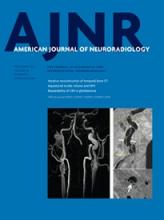We appreciate the comments from Joswig et al. In our article, we reported that the true incidence of warning headache is challenging to establish because it is difficult to obtain complete information from patients in poor clinical condition.1,2 Therefore, the diagnosis of a minor leak by interview has poor accuracy, and it is difficult to grasp the clinical implications of an interview-diagnosed minor leak. Thus, we investigated the clinical features of patients with minor leak diagnosed by T1-FLAIR mismatch at the time of admission.2
In our report, the incidence of patients whose history of warning headache was unknown by interview was high (46.5%, 59 of 127 cases). If we excluded these 59 patients whose history of warning headache was unknown by interview, warning headache determined by interview was 20.6% (14/68 patients). This is statistically similar to the percentage in the data of the letter by Joswig et al (24.2%) by the Fisher exact test (P = .424). Furthermore, the patients with warning headache diagnosed by interview had the same clinical features (elderly age, higher rate of rebleeding, intracerebral hemorrhage, and poor outcome) as patients diagnosed with minor leak by T1-FLAIR mismatch. The reasons for this discrepancy in clinical features between patients with warning headache diagnosed by interview in our data and patients with sentinel headache (SH) diagnosed by interview in the Joswig et al data are unknown. One reason may be the extremely low incidence of World Federation of Neurosurgical Societies (WFNS) grade I in patients with warning headache diagnosed by interview (43% [6 of 14] versus 81% [44 of 54] in patients without warning headache diagnosed by interview) in our data.
The overall percentage of WFNS grade I in patients who were able to confirm the presence or absence of a warning headache in an interview was high (74%, 50 of 68 patients), in contrast to that in patients whose history of warning headache was unknown by interview (36%, 21 of 59 patients). Thus, patients who could confirm the presence or absence of a warning headache in an interview had good status at admission, with patients presenting without a warning headache having the best prognosis. We think that the difference in clinical features of patients with warning headache between the 2 studies results from the low number of cases with poor clinical condition and the low number of the patients whose history of warning headache was unknown by interview in the data of Joswig et al. Furthermore, we think that there are too few cases in their data to examine the clinical features of patients with a warning headache. However, these opinions are speculative.
We agree with Joswig et al that SH preceding aneurysmal subarachnoid hemorrhage is not a rare phenomenon. We understand the importance of diagnosis at the time of SH preceding major attack. We expect further investigation by Joswig et al.
References
- © 2015 by American Journal of Neuroradiology







